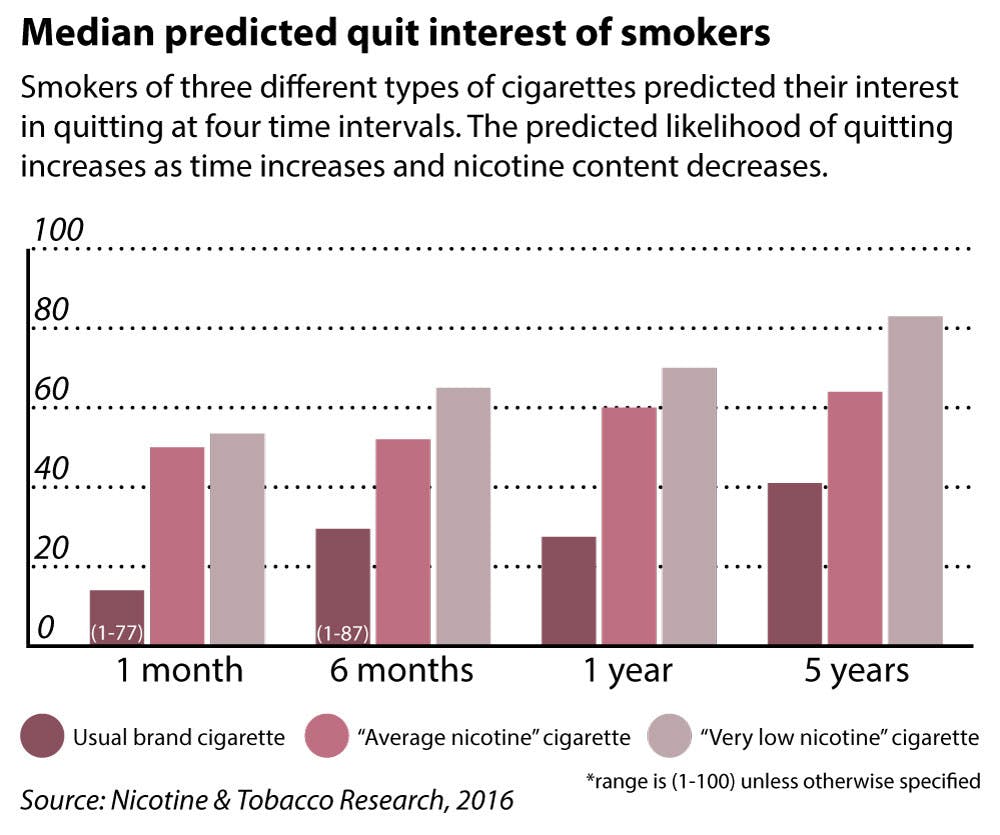In the past several years, researchers have tried to understand smokers’ perceptions of what they are putting into their bodies. A group of researchers led by Rachel Denlinger-Apte PhD’21 investigated how smokers expected low-nicotine cigarettes to affect their health. Participants rated the low-nicotine cigarettes as less satisfying but also less dangerous than average-nicotine cigarettes, according to the researchers’ article, published in Nicotine and Tobacco Research January 2017.
In previous studies that have explored smokers’ perception of reduced-nicotine cigarettes, subjects were not aware of the nicotine content. As a result, little is known about how smokers experience reduced-nicotine cigarettes when they are actually aware of the reduced content and how this knowledge may impact their use of these cigarettes.
The researchers hypothesized that the low-nicotine cigarettes would be perceived by smokers as “less risky” and would be rated as less desirable than normal-nicotine-content cigarettes. But “the (low-nicotine cigarette) itself is not less dangerous” because smokers still inhale toxic chemicals, Denlinger-Apte said.
To test their theory, the researchers recruited smokers in the Pittsburgh community aged 18 years or older who have smoked at least 10 cigarettes per day for the past year. Each participant was given two cigarettes in unmarked envelopes and was instructed to smoke them one at a time. “Both were very low-nicotine cigarettes, but for one cigarette, we said that it was low-nicotine. … For the other, we said that it was average nicotine,” Denlinger-Apte said.
Independent of the actual nicotine content but dependent on how the product was framed, participants “thought the (low-nicotine) product was less harmful” and less pleasurable to smoke than the cigarettes they regularly smoked.
“Given that (very low-nicotine-content cigarettes) might become useful as a step toward quitting smoking, the Denlinger-Apte study addressed the question of how acceptable (the cigarettes) might be to smokers,” said Damaris Rohsenow, associate director of the Center for Alcohol and Addiction Studies, who was unaffiliated with the study. “While participants rated the (very low-nicotine cigarettes) as less rewarding than their usual cigarettes, they also believed (they) would be less harmful to their health. (But they) are actually likely to be just as harmful to health since people are still exposed to carbon monoxide, tar and particles in the smoke.”
From these results, the researchers ultimately learned that “people confound or confuse nicotine with harm,” said Eric Donny, professor of psychology at the University of Pittsburgh and co-author of the study. “If you tell them (the cigarette) has less nicotine, they think that the cigarette is likely to be less harmful to them … and obviously that would be concerning if people kept smoking because of this.”
The findings of this study have significant implications when it comes to the Food and Drug Administration’s future policies. Jennifer Tidey, professor of psychiatry and human behavior, who was unaffiliated with the study, said the way the FDA frames the cigarette product will be important. “If the FDA proceeds with a reduced-nicotine standard for cigarettes sold in the United States, it will be extremely important that they use educational campaigns to inform smokers that they need to significantly reduce their smoking or quit completely in order to reduce the health risks associated with smoking,” she said. “Smoking very low-nicotine-content cigarettes does not by itself reduce the risks of smoking.”





